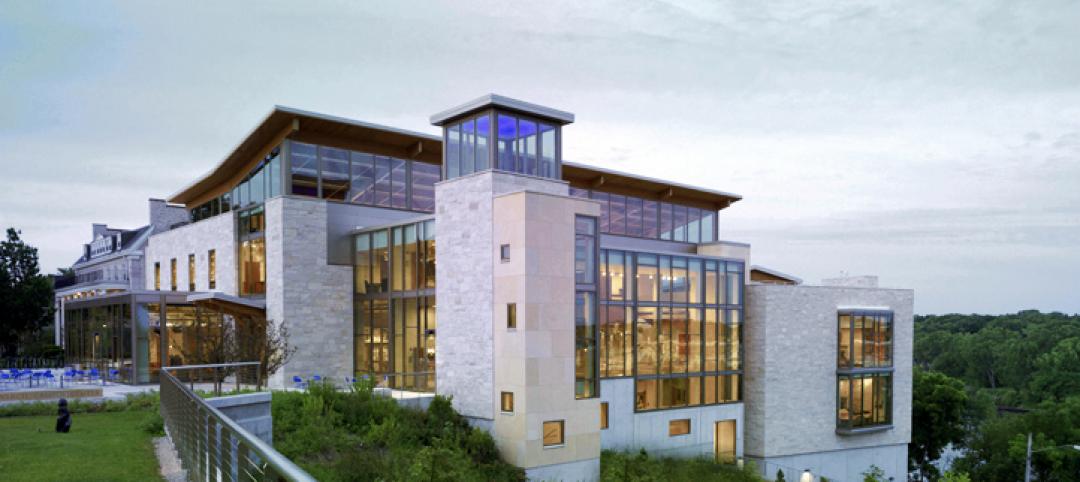This month, work crews began moving furniture, fixtures and equipment into USC Village, the biggest development project in the history of South Los Angeles, which is on schedule to be ready for the fall semester at the University of Southern California’s University Park campus.
The $700 million, 15-acre USC Village, which has been in the works since 2005, will consist of six buildings with a total of 1.25 million sf of space and 2,700 student beds. There will be eight residential colleges within USC Village, four of which had been endowed at presstime.
To view a flyover of the Village’s construction site, click here.
When USC Village was conceived, it was one of the first mixed-use residential college projects in the nation, and when completed it will include 100,000 sf of retail space for 30 tenants such as Bank of America, Starbucks, Target, and Trader Joe’s (which will be welcomed in South L.A. a food desert when it comes to supermarkets).
The Village will also have food and beverage outlets, and a 30,000-sf fitness center. The Village will provide 1,200 covered bike-parking slots, and another 500 slots for day-to-day bike parking by patrons of the gym or retail stores.
The exterior design of USC Village is best described as “collegiate gothic,” and reflects the mandate by USC’s president C.L. Max Nikias that the look of the Village be connected to the rest of the campus. “We could introduce any design feature, as long as it was gothic,” says Daniel Benjamin, AIA, LEED AP BD+C, Principal and Design Leader for Harley Ellis Devereaux, USC Village’s architect.
That meant a lot of detailing at the ground plane and roof level, but more traditional brick façade in the middle.
Benjamin notes that there weren’t enough masons in southern California to handle of project of this magnitude. So instead of importing workers from other parts of the state, the Building Team—which includes Hathaway Dinwiddie as the GC—decided to precast the concrete facades off site, typically delivered in 12- by 20-ft modules. Brick trimmed with sandblasted warm-colored concrete surrounds gives the buildings a three-dimensional sense of detail.
Prefabrication also cut the construction process, which began in June 2014, by nearly a year. These buildings are designed to last 80-100 years.
During the approval process, three major changes were made to USC Village’s plan, recalls Willy Marsh, USC’s director of construction. A large parking garage with a field on its roof became underground parking. High-rise residential towers became low-rise buildings. And a much larger retail center was de-emphasized. “The decision was made that retail wasn’t going to drive this project,” says Marsh.

The buildings' facade consists of precast concrete and brickface that mimics older buildings on campus. Image: USC
USC Village comprises about 20% of the University Park campus, and Nikias, says Benjamin, wanted the connections to be seamless. So the Village’s pathways and streets flow seamlessly into the larger campus’s circulation routes. More than 200 trees will be planted within and around the Village.
This campus is an integral part of the surrounding community. As part of this project, USC is providing $40 million in community benefits, including a $20 million contribution to an affordable housing fund that is managed by the city.
The number of student beds could increase to 5,000 if USC decides to redevelop a 12-acre lot adjacent to USC Village. Marsh says that project could be a decade away.
Related Stories
| Oct 14, 2011
University of New Mexico Science & Math Learning Center attains LEED for Schools Gold
Van H. Gilbert architects enhances sustainability credentials.
| Oct 12, 2011
Bulley & Andrews celebrates 120 years of construction
The family-owned and operated general contractor attributes this significant milestone to the strong foundation built decades ago on honesty, integrity, and service in construction.
| Sep 30, 2011
Design your own floor program
Program allows users to choose from a variety of flooring and line accent colors to create unique floor designs to complement any athletic facility.
| Sep 23, 2011
Okanagan College sets sights on Living Buildings Challenge
The Living Building Challenge requires projects to meet a stringent list of qualifications, including net-zero energy and water consumption, and address critical environmental, social and economic factors.
| Sep 14, 2011
Research shows large gap in safety focus
82% of public, private and 2-year specialized colleges and universities believe they are not very effective at managing safe and secure openings or identities.
| Sep 7, 2011
KSS Architects wins AIA NJ design award
The project was one of three to win the award in the category of Architectural/Non-Residential.
| May 18, 2011
Major Trends in University Residence Halls
They’re not ‘dorms’ anymore. Today’s collegiate housing facilities are lively, state-of-the-art, and green—and a growing sector for Building Teams to explore.
| May 18, 2011
Raphael Viñoly’s serpentine-shaped building snakes up San Francisco hillside
The hillside location for the Ray and Dagmar Dolby Regeneration Medicine building at the University of California, San Francisco, presented a challenge to the Building Team of Raphael Viñoly, SmithGroup, DPR Construction, and Forell/Elsesser Engineers. The 660-foot-long serpentine-shaped building sits on a structural framework 40 to 70 feet off the ground to accommodate the hillside’s steep 60-degree slope.















